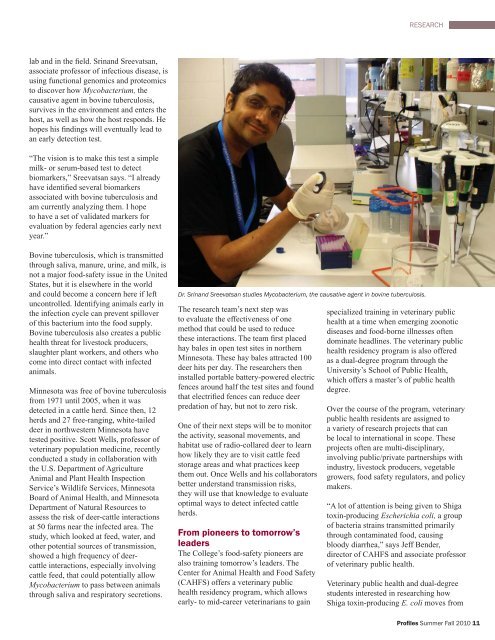Summer/Fall 2010 PDF Version - University of Minnesota College of ...
Summer/Fall 2010 PDF Version - University of Minnesota College of ...
Summer/Fall 2010 PDF Version - University of Minnesota College of ...
Create successful ePaper yourself
Turn your PDF publications into a flip-book with our unique Google optimized e-Paper software.
RESEARCH<br />
lab and in the field. Srinand Sreevatsan,<br />
associate pr<strong>of</strong>essor <strong>of</strong> infectious disease, is<br />
using functional genomics and proteomics<br />
to discover how Mycobacterium, the<br />
causative agent in bovine tuberculosis,<br />
survives in the environment and enters the<br />
host, as well as how the host responds. He<br />
hopes his findings will eventually lead to<br />
an early detection test.<br />
“The vision is to make this test a simple<br />
milk- or serum-based test to detect<br />
biomarkers,” Sreevatsan says. “I already<br />
have identified several biomarkers<br />
associated with bovine tuberculosis and<br />
am currently analyzing them. I hope<br />
to have a set <strong>of</strong> validated markers for<br />
evaluation by federal agencies early next<br />
year.”<br />
Bovine tuberculosis, which is transmitted<br />
through saliva, manure, urine, and milk, is<br />
not a major food-safety issue in the United<br />
States, but it is elsewhere in the world<br />
and could become a concern here if left<br />
uncontrolled. Identifying animals early in<br />
the infection cycle can prevent spillover<br />
<strong>of</strong> this bacterium into the food supply.<br />
Bovine tuberculosis also creates a public<br />
health threat for livestock producers,<br />
slaughter plant workers, and others who<br />
come into direct contact with infected<br />
animals.<br />
<strong>Minnesota</strong> was free <strong>of</strong> bovine tuberculosis<br />
from 1971 until 2005, when it was<br />
detected in a cattle herd. Since then, 12<br />
herds and 27 free-ranging, white-tailed<br />
deer in northwestern <strong>Minnesota</strong> have<br />
tested positive. Scott Wells, pr<strong>of</strong>essor <strong>of</strong><br />
veterinary population medicine, recently<br />
conducted a study in collaboration with<br />
the U.S. Department <strong>of</strong> Agriculture<br />
Animal and Plant Health Inspection<br />
Service’s Wildlife Services, <strong>Minnesota</strong><br />
Board <strong>of</strong> Animal Health, and <strong>Minnesota</strong><br />
Department <strong>of</strong> Natural Resources to<br />
assess the risk <strong>of</strong> deer-cattle interactions<br />
at 50 farms near the infected area. The<br />
study, which looked at feed, water, and<br />
other potential sources <strong>of</strong> transmission,<br />
showed a high frequency <strong>of</strong> deercattle<br />
interactions, especially involving<br />
cattle feed, that could potentially allow<br />
Mycobacterium to pass between animals<br />
through saliva and respiratory secretions.<br />
Dr. Srinand Sreevatsan studies Mycobacterium, the causative agent in bovine tuberculosis.<br />
The research team’s next step was<br />
to evaluate the effectiveness <strong>of</strong> one<br />
method that could be used to reduce<br />
these interactions. The team first placed<br />
hay bales in open test sites in northern<br />
<strong>Minnesota</strong>. These hay bales attracted 100<br />
deer hits per day. The researchers then<br />
installed portable battery-powered electric<br />
fences around half the test sites and found<br />
that electrified fences can reduce deer<br />
predation <strong>of</strong> hay, but not to zero risk.<br />
One <strong>of</strong> their next steps will be to monitor<br />
the activity, seasonal movements, and<br />
habitat use <strong>of</strong> radio-collared deer to learn<br />
how likely they are to visit cattle feed<br />
storage areas and what practices keep<br />
them out. Once Wells and his collaborators<br />
better understand transmission risks,<br />
they will use that knowledge to evaluate<br />
optimal ways to detect infected cattle<br />
herds.<br />
From pioneers to tomorrow’s<br />
leaders<br />
The <strong>College</strong>’s food-safety pioneers are<br />
also training tomorrow’s leaders. The<br />
Center for Animal Health and Food Safety<br />
(CAHFS) <strong>of</strong>fers a veterinary public<br />
health residency program, which allows<br />
early- to mid-career veterinarians to gain<br />
specialized training in veterinary public<br />
health at a time when emerging zoonotic<br />
diseases and food-borne illnesses <strong>of</strong>ten<br />
dominate headlines. The veterinary public<br />
health residency program is also <strong>of</strong>fered<br />
as a dual-degree program through the<br />
<strong>University</strong>’s School <strong>of</strong> Public Health,<br />
which <strong>of</strong>fers a master’s <strong>of</strong> public health<br />
degree.<br />
Over the course <strong>of</strong> the program, veterinary<br />
public health residents are assigned to<br />
a variety <strong>of</strong> research projects that can<br />
be local to international in scope. These<br />
projects <strong>of</strong>ten are multi-disciplinary,<br />
involving public/private partnerships with<br />
industry, livestock producers, vegetable<br />
growers, food safety regulators, and policy<br />
makers.<br />
“A lot <strong>of</strong> attention is being given to Shiga<br />
toxin-producing Escherichia coli, a group<br />
<strong>of</strong> bacteria strains transmitted primarily<br />
through contaminated food, causing<br />
bloody diarrhea,” says Jeff Bender,<br />
director <strong>of</strong> CAHFS and associate pr<strong>of</strong>essor<br />
<strong>of</strong> veterinary public health.<br />
Veterinary public health and dual-degree<br />
students interested in researching how<br />
Shiga toxin-producing E. coli moves from<br />
Pr<strong>of</strong>iles <strong>Summer</strong> <strong>Fall</strong> <strong>2010</strong> 11

















